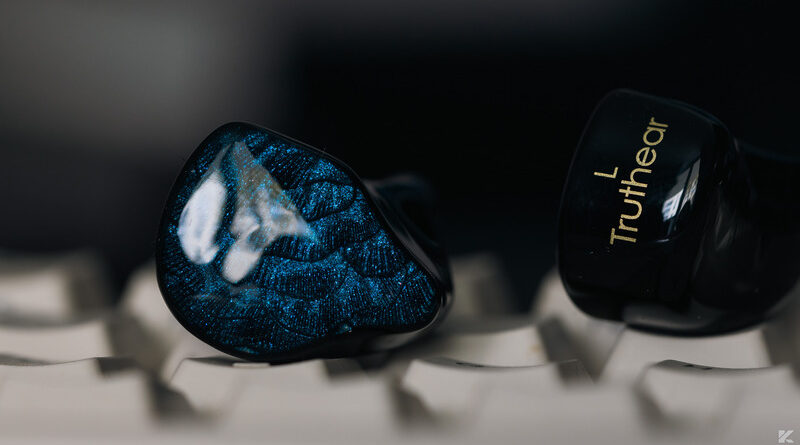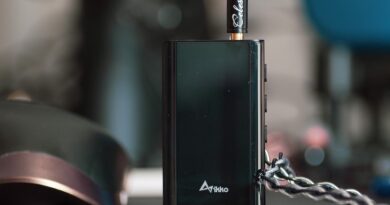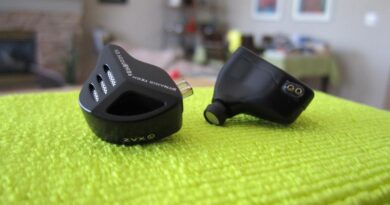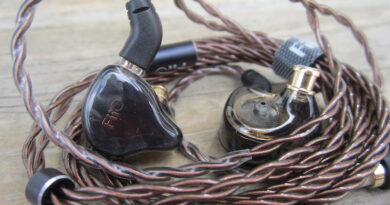Truthear Nova Review – Hitting the Mark
Pros — Good accessories
– Comfortable fit
– Strong sub-bass rumble
– Smooth treble that resolves fairly well
– Good imaging and instrument separation
Cons — The Truthear Nova have thin-sounding lower-mids
– Upper-midrange glare in tracks with low sub-bass
– BA timbre
– Microdynamics are not so evident
In this Article
INTRODUCTION
Truthear has garnered a certain cult following, thanks to a fairly “solid” series of IEMs, albeit all of them in the <USD$100 range. The brand’s latest release, Nova, aim to change the strictly “budget” outlook of the brand. At $150, the Nova are the most expensive product Truthear has released so far.
With higher price comes loftier expectations. Time to see how well the Nova can manage that weight.
Note: the ratings given will be subjective to the price tier. Heartfelt thanks to Shenzhenaudio for sending the Truthear Nova in for evaluation.
Sources used: Cayin RU7, Questyle CMA Twelve Master
Price, while reviewed: $150. Can be bought from Shenzhenaudio.
PHYSICAL THINGS AND USABILITY
PACKAGING AND ACCESSORIES
Truthear remains true to its “waifu art” packaging. You can even order an acrylic cutout of the “waifu” during the purchase process. Well, I am not the intended audience for this but I guess there is a demand out there for such “perks”.
The packaging is quite large but there is a lot of wasted space for the sake of a more appealing arrangement of the accessories. I mean, one can easily just bundle the tips in small zip-lock bags, but I digress.
Other than the silicone and foam tips, you also get a PU leather carry case that doesn’t offer a lot of protection but looks cool nonetheless. The stock cable has a visually striking black and blue color scheme, but the length is longer than your standard 1.2m cables, resulting in a more cumbersome experience while walking around.
BUILD QUALITY
The Nova have similar glossy, slippery, and fingerprint-attracting black shells as the Truthear Zero. Other than the faceplate design, the overall aesthetics have many similarities with the budget model.
This is somewhat perplexing as I assumed Truthear would go for a more premium build or at least a different finish for the resin shell. Nonetheless, “premium” is not a word I can associate with the Nova’s overall build. It’s serviceable, decent even – but not something noteworthy.
There are three different sound-bores, with each of them channeling sound from separate driver arrays. The 2-pin port is, thankfully, recessed and there are 4 vents on the side to alleviate pressure and also allow the dynamic driver to have additional air to move around.
COMFORT, ISOLATION, AND FIT
Despite the nozzle being on the thicker side, the Nova have very good fit and comfort. Isolation is good with the supplied foam tips, but not class-leading.
SOURCE AND EARTIPS
At a sensitivity of 108 dB/mW into 15 ohms, the Truthear Nova are fairly easy to drive. Do note that the crossover circuit is prone to impedance mismatch, so a source with low output impedance is recommended. For this review, I used stock tips and cable, and the Cayin RU7 dongle.
DRIVER SETUP
The Nova utilize a 1DD + 4BA setup, with the DD being in charge of the sub-bass and the mid-bass, while the BA drivers handle the mids and highs. The BA drivers are dual-BAs, so they occupy less space inside the shells. Each driver has a separate acoustic tube/wave-guide attached to channel the sound into the bores.
Finally, there are dampers placed in the nozzle for attenuating resonant frequencies and aberrant peaks. A fairly competent driver setup and kudos to Truthear for nailing down the basics and then some.
TONALITY AND TECHNICALITIES
The Truthear Nova are Harman-neutral (2019 V2), apart from some subtle deviations. They are perhaps the most “true Harman” IEMs you can get under USD$200, so if you love Harman tuning and religiously abide by it – skip the rest of the review and grab a pair right now.
For those who have their reservations about Harman – there is more to the story than meets the eye.
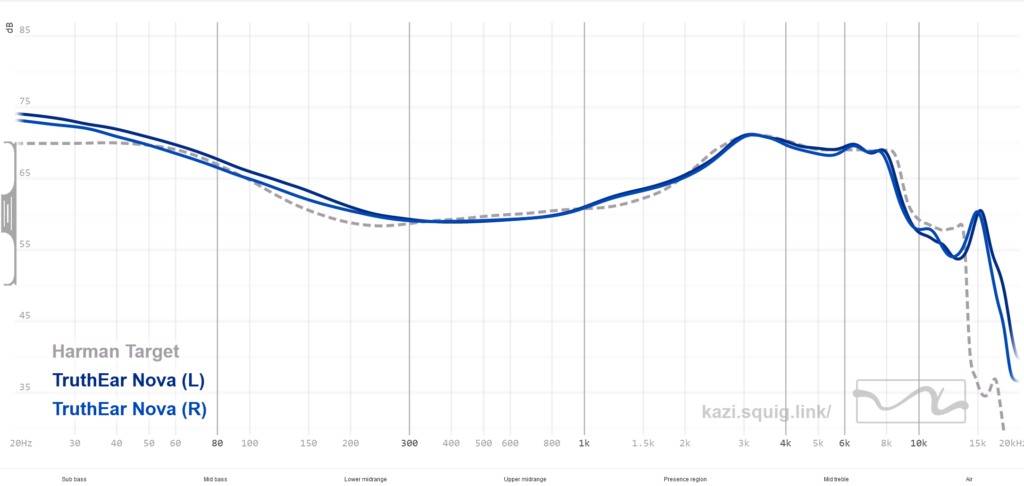
The tell-tale sub-bass shelf is here to stay, with a sudden rise from about 300Hz downward. Understandably, the upper-mids need to be pushed upward to counter-balance the sub-bass dominance and to ensure that vocals have enough clarity and forwardness.
I strongly believe that a pair of IEMs’ bass response is only as good as the driver allows it to be. With a subpar or under-performing driver, the bass will lack authority, slam, and texture. No amount of EQ shenanigans can compensate for high distortion characteristics. Fortunately, the Nova have a pretty decent dynamic driver for the “woofer”.
Bass has good slam and rumble and doesn’t break up or distort even at higher volumes. Bass texture is lacking, but some of that can be attributed to the mid-bass thinness which is a point of contention about the Harman target itself. Either way, bass is satisfyingly deep and punchy for the most part, and can provide the “macrodynamism” one expects from sudden bass drops, for example.
The lower-mids can come across as “thin” at times, especially if you are accustomed to the sound of certain old speakers, or reference headphones like Sennheiser HD 650. Baritone vocals lack the heft while snare hits can sound anemic, lacking in density.
Upper-mids, meanwhile, take the center stage with female vocals being noticeably more forward than the male vocals. This forwardness can be engaging if there is enough bass in the recording to balance things out. In acoustic tracks with low or no sub-bass , the balance gets skewed towards the upper-midrange instead, resulting in shout and shrillness. if your library rarely consists of such tracks, this should not be an issue. Otherwise, take note.
The treble is quite dark past 7kHz. There is a steep roll-off with not much upper-treble to add air into the mix. Treble can at times exhibit BA timbre, with cymbals and hi-hats lacking the note weight one expects. Due to the lack of airiness, cymbals abruptly stop “ringing” and the decay is unnaturally fast. This also limits the perceived “wideness” of the soundstage, even though the Nova do not sound closed-in.
Imaging is precise, with only ordinal directions being somewhat difficult to pinpoint. Instrument separation is another strong area of the Nova, as even in busy tracks it is easy to figure things out individually.
Microdynamics (subtle shifts in volume) are not so evident on the Truthear Nova, resulting in somewhat of a flat representation of music.
SELECT COMPARISONS
Truthear Nova vs Simgot EM6L
Simgot EM6L are noticeably cheaper than the Truthear Nova and come with a less flashy design and arguably worse accessories. Comfort is similar on both, while isolation is slightly better on the Simgot IEMs. Ironically, both these IEMs share the same driver configuration: 1DD + 4BA, though Simgot utilizes a smaller 8mm dynamic driver compared to the 10mm driver on Nova.
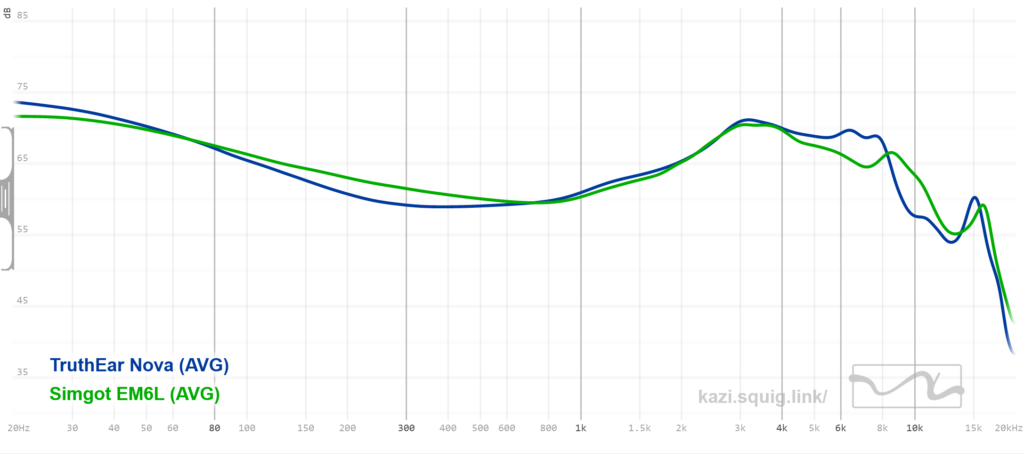
As for the sound, EM6L also closely follow the Harman 2019 V2 with a distinct deviation near the mid-bass where Simgot decided to fill up the “suck-out” around 250Hz. This noticeably improves male vocals and the rendition of percussion instruments. Upper treble is slightly more pronounced on the EM6L compared to the Nova (and Harman IE target), resulting in better perceived airiness, albeit the differences are minimal.
Imaging is about similar on both of these IEMs, though EM6L render microdynamics more convincingly.
In the end, I prefer the EM6L overall, not only because it offers similar performance for significantly less, but also because the tuning “fixes” aligns them closer to my preferences.
CONCLUDING REMARKS
The Truthear Nova are competent IEMs. Tonal preferences aside, there are no glaring flaws in the overall package, be it technicalities or build/accessories. It’s just that the competition is offering the same, if not more, for less. And that’s where things get tricky.
The current IEM market is a race to the bottom: a frenzied hustle to give the customers the “best” for the “least”. Truthear built its reputation based on that very mission statement but competition has not only caught up, rather they’ve turned the whole game on its head by driving prices down further.
So, while the Nova indeed hit their target: a mid-tier Harman-abiding pair of IEMs with decent technicalities, they find themselves late to the party. Unless you are really afraid of mid-bass, there are better options out there. But if it’s Harman you want in its pure, unadulterated form – the Nova will have your back.
MY VERDICT
3.5/5
DISCLAIMER
Get it from Shenzhenaudio.
Our generic standard disclaimer.
You find an INDEX of our most relevant technical articles HERE.



